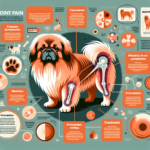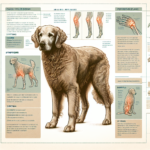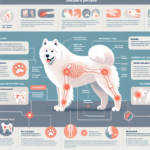Pekingese Joint Pain: Causes, Symptoms, Prevention, and Treatment

Introduction
The Pekingese, a breed with a rich history and distinctive appearance, has long been cherished for its regal demeanor and loyal companionship. Originating from ancient China, the Pekingese was a favored pet among Chinese royalty, often seen as a symbol of nobility and elegance. Characterized by their lion-like mane, flat face, and compact body, Pekingese dogs are small but sturdy, with a personality that is both affectionate and independent.
Despite their many endearing qualities, Pekingese dogs are prone to several health issues, one of the most significant being joint pain. This article delves into the causes, symptoms, prevention, and treatment of joint pain in Pekingese dogs, providing a comprehensive guide for owners to ensure their pets lead a comfortable and healthy life.
Breed-Specific Joint Pain Risks
Genetic Predisposition
Pekingese dogs are genetically predisposed to several joint-related issues. Hip dysplasia, a condition where the hip joint doesn’t fit properly into the hip socket, is relatively common in this breed. Additionally, Pekingese dogs may suffer from patellar luxation, where the kneecap dislocates from its normal position. Arthritis, a degenerative joint disease, is also prevalent, particularly as the dog ages.
Age-Related Risks
As Pekingese dogs age, the risk of developing joint pain increases. Typically, signs of joint issues may start to appear around middle age, which for Pekingese is around 5 to 7 years old. However, some dogs may show symptoms earlier, especially if they have a genetic predisposition or have experienced joint injuries.
Activity Level and Joint Stress
While Pekingese dogs are not as active as some other breeds, their compact and sturdy build can still lead to joint stress. Activities such as jumping off furniture or climbing stairs can put undue pressure on their joints. Additionally, their unique body structure, with a relatively long back and short legs, can contribute to spinal and joint issues over time.
Common Symptoms of Joint Pain in Pekingese
General Symptoms
- Limping: One of the most noticeable signs of joint pain is limping or favoring one leg over another.
- Stiffness: Stiffness, especially after resting or sleeping, can indicate joint discomfort.
- Reluctance to Move: A dog that is hesitant to jump, climb stairs, or go for walks may be experiencing joint pain.
- Swelling: Swelling around the joints can be a sign of inflammation and pain.
- Behavioral Changes: Increased irritability or changes in behavior can also be indicative of pain.
Breed-Specific Symptoms
In Pekingese dogs, joint pain may also manifest as a reluctance to be picked up or held, due to discomfort in their spine or hips. Additionally, their unique gait may become more pronounced or awkward as they try to compensate for joint pain.
When to Consult a Vet
If you notice any of the above symptoms in your Pekingese, it is crucial to consult a veterinarian. Early diagnosis and treatment can significantly improve your dog’s quality of life and prevent further joint damage.
Preventive Measures for Joint Health
Exercise Recommendations
Regular, moderate exercise is essential for maintaining joint health in Pekingese dogs. Short walks and gentle play sessions can help keep their joints flexible without causing undue stress. Avoid high-impact activities like jumping or running on hard surfaces.
Dietary Suggestions
A balanced diet rich in essential nutrients can support joint health. Consider incorporating foods or supplements that contain glucosamine, chondroitin, and omega-3 fatty acids, which are known to promote joint health and reduce inflammation.
Weight Management
Maintaining a healthy weight is crucial for reducing joint stress. Overweight Pekingese dogs are at a higher risk of developing joint issues. Regularly monitor your dog’s weight and adjust their diet and exercise routine as needed to keep them at an optimal weight.
Early Screening and Monitoring
Regular veterinary check-ups are essential for early detection of joint issues. Your vet may recommend specific screening tests, such as X-rays or joint fluid analysis, to monitor your dog’s joint health and catch any problems early.
Treatment Options for Joint Pain
Non-Surgical Treatments
Non-surgical treatments for joint pain in Pekingese dogs include:
- Medications: Anti-inflammatory drugs and pain relievers can help manage pain and reduce inflammation.
- Physical Therapy: Physical therapy exercises can improve joint flexibility and strength.
- Lifestyle Adjustments: Modifying your dog’s activity level and environment can help reduce joint stress.
Surgical Options
In severe cases, surgical intervention may be necessary. Common surgical options include:
- Hip Replacement: For dogs with severe hip dysplasia, hip replacement surgery can provide significant relief.
- Arthroscopy: A minimally invasive procedure to clean out the joint and remove damaged tissue.
- Joint Fusion: In cases of severe arthritis, joint fusion surgery can stabilize the joint and reduce pain.
Alternative Therapies
Alternative therapies can also be beneficial for managing joint pain in Pekingese dogs. These include:
- Acupuncture: Acupuncture can help reduce pain and improve joint function.
- Hydrotherapy: Swimming or water therapy can provide low-impact exercise that is gentle on the joints.
- Massage: Regular massage can help improve circulation and reduce muscle tension around the joints.
Lifestyle and Management Tips
Daily Care Routine
A sample daily care routine for managing joint pain in Pekingese dogs might include:
- Morning: Gentle walk and joint supplements with breakfast.
- Afternoon: Short play session with low-impact toys.
- Evening: Another gentle walk and a massage session.
- Night: Ensure your dog sleeps on an orthopedic bed for added joint support.
Modifying the Home Environment
Making your home more comfortable for a dog with joint pain can significantly improve their quality of life. Consider the following modifications:
- Install ramps to help your dog navigate stairs or get onto furniture.
- Provide an orthopedic bed to support their joints while they sleep.
- Keep their living area free of obstacles to prevent trips and falls.
Long-Term Management
Long-term management of joint pain involves regular veterinary check-ups, consistent exercise, a balanced diet, and weight management. By staying proactive and attentive to your dog’s needs, you can help them lead a happy and active life despite joint pain.
FAQs About Pekingese and Joint Pain
What are the early signs of joint pain in Pekingese dogs?
Early signs of joint pain include limping, stiffness, reluctance to move, and behavioral changes such as increased irritability.
Can joint pain in Pekingese dogs be prevented?
While genetic predispositions cannot be entirely prevented, maintaining a healthy weight, providing regular exercise, and ensuring a balanced diet can help reduce the risk of joint pain.
Are there specific exercises that are better for Pekingese dogs with joint pain?
Yes, low-impact exercises such as short walks and gentle play sessions are ideal for Pekingese dogs with joint pain. Avoid high-impact activities like jumping or running on hard surfaces.
What dietary supplements can help with joint health in Pekingese dogs?
Supplements containing glucosamine, chondroitin, and omega-3 fatty acids are known to support joint health and reduce inflammation.
When should I consider surgery for my Pekingese’s joint pain?
Surgery should be considered if non-surgical treatments are ineffective and your dog is experiencing severe pain or mobility issues. Consult your veterinarian for a thorough evaluation and recommendation.
Conclusion
Joint pain is a common issue in Pekingese dogs, but with proper care and attention, it can be managed effectively. By understanding the causes, symptoms, prevention, and treatment options, owners can ensure their Pekingese lead a comfortable and active life. Regular veterinary check-ups, a balanced diet, appropriate exercise, and weight management are key to maintaining joint health. If you notice any signs of joint pain in your Pekingese, consult your veterinarian promptly to develop a comprehensive care plan tailored to your dog’s needs.




